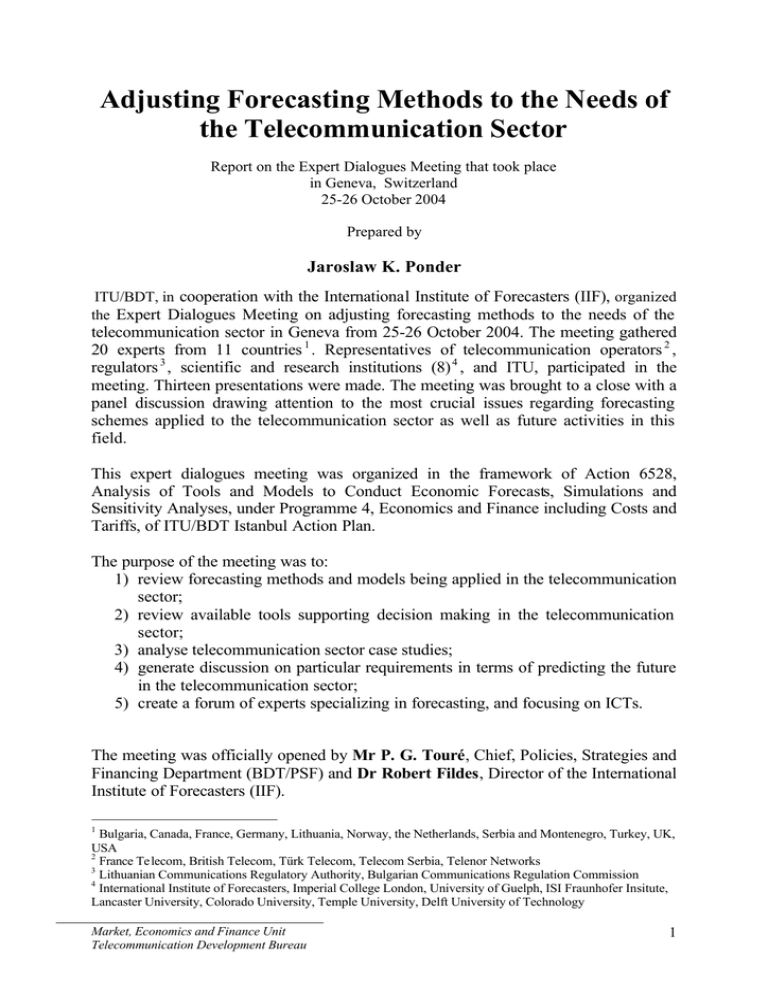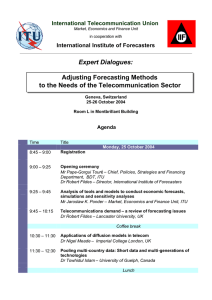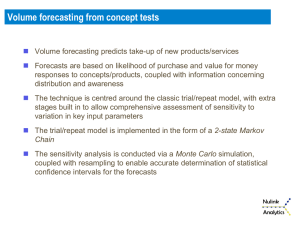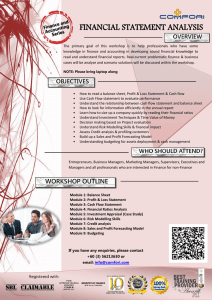Adjusting Forecasting Methods to the Needs of the Telecommunication Sector
advertisement

Adjusting Forecasting Methods to the Needs of the Telecommunication Sector Report on the Expert Dialogues Meeting that took place in Geneva, Switzerland 25-26 October 2004 Prepared by Jaroslaw K. Ponder ITU/BDT, in cooperation with the International Institute of Forecasters (IIF), organized the Expert Dialogues Meeting on adjusting forecasting methods to the needs of the telecommunication sector in Geneva from 25-26 October 2004. The meeting gathered 20 experts from 11 countries 1 . Representatives of telecommunication operators 2 , regulators 3 , scientific and research institutions (8) 4 , and ITU, participated in the meeting. Thirteen presentations were made. The meeting was brought to a close with a panel discussion drawing attention to the most crucial issues regarding forecasting schemes applied to the telecommunication sector as well as future activities in this field. This expert dialogues meeting was organized in the framework of Action 6528, Analysis of Tools and Models to Conduct Economic Forecasts, Simulations and Sensitivity Analyses, under Programme 4, Economics and Finance including Costs and Tariffs, of ITU/BDT Istanbul Action Plan. The purpose of the meeting was to: 1) review forecasting methods and models being applied in the telecommunication sector; 2) review available tools supporting decision making in the telecommunication sector; 3) analyse telecommunication sector case studies; 4) generate discussion on particular requirements in terms of predicting the future in the telecommunication sector; 5) create a forum of experts specializing in forecasting, and focusing on ICTs. The meeting was officially opened by Mr P. G. Touré, Chief, Policies, Strategies and Financing Department (BDT/PSF) and Dr Robert Fildes, Director of the International Institute of Forecasters (IIF). 1 Bulgaria, Canada, France, Germany, Lithuania, Norway, the Netherlands, Serbia and Montenegro, Turkey, UK, USA 2 France Telecom, British Telecom, Türk Telecom, Telecom Serbia, Telenor Networks 3 Lithuanian Communications Regulatory Authority, Bulgarian Communications Regulation Commission 4 International Institute of Forecasters, Imperial College London, University of Guelph, ISI Fraunhofer Insitute, Lancaster University, Colorado University, Temple University, Delft University of Technology Market, Economics and Finance Unit Telecommunication Development Bureau 1 After the opening remarks, Mr Pape G. Touré, made the first presentation, dedicated to the meaning of the chaos theory in terms of forecasting the needs of the telecommunication sector. Mr Touré began his presentation with assumptions of the chaos theory, and argued that each system faces complex and dynamic behaviour that can be unpredictable. The initial conditions may influence the course of later occurrences that, in the chaos theory, are known as the “butterfly effect”. With the complex and non-linear system, small changes in the starting conditions of a system can result in different outputs for that system. Moreover, the elements of the chaotic system can appear in total disarray, making pattern recognition impossible. For this reason, traditional forecasting tools are sometimes not appropriate for specific situations, especially in the context of liberalized telecommunication markets. Extensive investigation leading to the identification of critical leverage points within the complex system can be helpful in terms of forecasting optimization or reduction of uncertainty. During the presentation Mr Touré demonstrated a tool that had been developed for the purposes of his presentation, showing different outcomes of simulations under different assumptions. The second presentation was given by Mr Jaroslaw Ponder who demonstrated the components of action 6528 “Analysis of Tools and Models to Conduct Economic Forecasts, Simulations and Sensitivity Analyses”. The presentation: “Telecommunication Demand: A Review of Forecasting Issues” was made by Dr Robert Fildes of Lancaster University and Director of the International Institute of Forecasters (IIF). After a brief definition of the demand structure in the telecommunication sector, Dr Fildes pointed out the variety of telecommunication forecasting problems, focusing on four areas: a) stable markets – aggregate, b) stable markets – disaggregate, c) growth markets with special services and new services, and d) operations. Dr Fildes also addressed the question of forecasting opportunities from the perspective of market potential. He drew attention to the problem of segmentation and its application to forecasting, to models of interacting individuals, underlining the effect of networks on different adoption patterns, and analysed the advantages of diffusion models and simulation modelling. He concluded with comments on the effects of forecasting on the performance of organisations. The presentation, “Applications of Diffusion Models in Telecommunications” was made by Dr Nigel Meade, Imperial College London. In his presentation Dr Meade dealt with recent examples of diffusion models in the telecommunication sector. He defined a set of questions to be answered by each diffusion modelling exercise, e.g. what the rate of adoption will be at a particular time, how many potential adopters there are in total, when peak demand will occur, and how high peak demand is. In Dr Meade’s opinion the most important forecasting problems are the following: identification of the appropriate model, estimation of its parameters, and prediction of future adoption. He indicated that literature reveals at least 29 possible models and that there is no single universal model fitting all situations. Dr Meade focussed on different Market, Economics and Finance Unit Telecommunication Development Bureau 2 modelling approaches such as extrapolation from available data, dynamic saturation level in relation to environmental variables, multi-national models, multi-generation models, multi-technology models, and demonstrated their advantages and disadvantages. The presentation on “Pooling Multi-country Data: Short Data and Multigenerations of Technologies” was made by Dr Towhidul Islam from the University of Guelph, Canada, and dealt with the problem of lack of data and pooling short data methodology as useful solutions for the purpose of forecasting in telecommunications. Starting with the general research objectives of each forecasting exercise Dr. Islam demonstrated two examples of pooling short data on the basis of a) single generation multi-country data, and b) multi-generation multi-country data. In the first case he pointed out the following pooling techniques: fixed effect model, cross-sectionally varying (CSV) model, random effect model and random coefficient model. In the second case, after review of the work - that has been done on the multi generation diffusion model (single country and multi-country) - he demonstrated the modelling case study based on the Norton and Bass model with the incorporation of multigeneration cellular data and covariates of the multi-generation diffusion model. He then addressed a further research stream, the duration time between key events hazard model approach - where the research objective is to predict duration probabilities of future events conditional on covariates and past events. The presentation: “The Delphi methodology and other impact assessment methodologies: Opportunities and challenges for standardization and regulation bodies in the telecommunication sector” given by Dr Knut Blind from the Fraunhofer Institute for Systems and Innovation Research ISI, Germany, was dedicated to the meaning of qualitative techniques of forecasting - more precise judgmental methods - for the needs of the telecommunication sector. According to Dr Blind, standardisation institutions and regulatory bodies face many problems in terms of the adjustment of decisions to future developments as a result of continuous changes in technology, markets and society. Dr Blind explained the general model of the foresight process which consists of three components: a) creation of topics, b) structured survey, and c) participative discussion. Dr Blind described the Delphi method, which was applied in the field of information and communication technologies in different countries last year - Germany (Delphi 98), Japan (2001). He went on to show the results from the first step of the Delphi exercise which was prepared especially for the purposes of the Expert Dialogues meeting. Dr Blind presented an overview of impact assessment methods, i.e. surveys, econometric models, control group approaches, cost benefit analysis, expert panels, case studies, network analysis, foresight studies and benchmarking. He explained the achievements of the European project on regulation and innovation, based on surveys. Using this example he concluded that this methodology delivers measures for the quantitative and qualitative assessment of impacts, ex post and ex ante assessment, and micro data. The advantages of the surveys are their ability to recognise kind, size and distribution of impacts as well as generalisation of results. On the other hand, the surveys are very time-consuming and there are many difficulties in terms of answering counterfactual Market, Economics and Finance Unit Telecommunication Development Bureau 3 questions. The foresight studies method allows for a qualitative and semi-qualitative impact, ex ante decision making, qualitative and semi-qualitative data, e.g. from Delphi surveys. The advantages are the following: a) a consensus-building process regarding impacts, b) articulation and road mapping of new technologies. The most important disadvantages of the foresight studies are: a) it is not possible to take into account major technological breakthroughs, b) uncertainty that increases with complexity and future time horizon. In conclusion Dr. Blind recommended application of the foresights to focus on technology, market, impact dimension as well as ex ante and ex post analyses. He considered it important to apply different methods or even a combination of approaches. The presentation on “Examining forecasting methodologies to assist and support operators in the transition from a regulated environment to deregulated markets” given by Mr Mohsen Hamoudia, France Telecom, was dedicated to experiences of the telecom operator in the field of forecasting. In his presentation Mr Hamoudia shed light on the dynamic character of the telecommunication sector and concluded that the modelling and forecasting techniques in the telecom industry are significantly influenced by the changing environment. According to Mr Hamoudia, historical players (incumbents) must re-engineer, adopt and reshape forecasting processes and techniques. The “new” and more suitable forecasting techniques should be driven by market changes. Mr Hamoudia focused on the limitations of traditional forecasting methods and models in the context of competitive markets. Using an example of a dataset of traffic he demonstrated the differences in outcome by application of traditional forecasting models as well as the outcome from the adaptation of forecasting models to a new situation. After a review of the main forecasting methods used before deregulation in 1998, Mr Hamoudia indicated the needs for improvement of the modelling process in the field of econometric modelling, time series modelling, growth curves/s-curves, specific models for each customer segment, information and data. Mr Hamoudia presented a case study based on the experiences of an important operator in international traffic, outlining the forecasting methods undertaken and how they held up to the challenges of liberalization in 1998. Mr Hamoudia concluded that telecom forecasting models must take into account the following components: more adequate explanatory variables, the dynamics of demand and supply, necessity of demand segmentation, the players’ behaviour and strategies, flexibility of pricing strategy, and new traffic routing strategies. According to Mr Hamoudia it is necessary: a) to integrate into the forecasting process, other contributions outside the econometric model (e.g. learning from customer surveys, market studies, trade-off studies), b) to learn from the experience of deregulated and competitive telecom markets e.g. UK, USA, Australia, c) to set-up and use re-forecasting processes. The presentation given by Mr Kjell Stordahl, Nortel, consisted of two components: the first on forecasting models for cost evolution of network components, and the second on risk analysis based on uncertainties in demand forecasts and cost predictions. In the first part of the presentation Mr Stordahl drew attention to Write and Crawford´s Learning Curve Model where the cost should be a function of time. Market, Economics and Finance Unit Telecommunication Development Bureau 4 This methodology has been used in many telecommunication projects in recent years. Mr Stordahl emphasised that the most important advantages of the extended learning curve model are the following: a) the model makes forecasts of component costs, b) the model has the possibility to include both a priori knowledge and statistical information at the same time, c) the model can be used to forecast component costevolution even if no cost observations are known, d) the model can be used to forecast component costs based on estimation of the parameters when historical costs are available. In the second part of the presentation Mr Stordahl concentrated on risk analysis based on uncertainties in demand forecasts and cost predictions. According to Mr Stordahl the objective of this part of his presentation was, a) to demonstrate how risk analysis is applied on a specific business case for evaluation of economic risk, b) to present the methodology for fitting the probability densities of critical variables in the business case, c) to show the effect by modelling dependency between ARPU and demand in the risk simulations, d) to draw attention to the risk framework that has been developed through numerous European programmes e.g. RACE, ACTS and IST. The presentation on “Complexity based business decision support tools for telecommunication applications” made by Mr David Collings, BT Exact, was dedicated to the complexity of approaches to forecasting in British Telecom. After a short introduction Mr Collings presented possible techniques for purposes of social and economic modelling, i.e. statistical physics, ABM (market and consumers analysis) and game theory (strategy analysis). Their efficiency depends on two factors - number of interactions and complexity of decision processes. As the real world consists of a large number of interactions with complex behaviour, the ABM technique becomes the most appropriate one. Mr Collings described the above-mentioned technique giving various examples of its application in real life. Finally, Mr Collings concluded that a) models always have limitations, b) there is such a thing as a useful model, c) a good modelling process consists of extraction and sharing of knowledge, facilitation of discussion, as well as clarification of limitations. He declared that a model should allow for experimentation and the manipulation of parameters that exist in real life, which is especially important in socio-economic systems. From this point of view the complexity approach (ABM) could be the ideal technique. The presentation on “Understanding consumer behaviour in information and communication technologies” was made by Mr Alastair Robertson, Lancaster University. After a brief introduction on the dynamics of ICTs Mr Robertson presented the theoretical approach on consumer adoption of technologies and demonstrated the application of the technology acceptance model based on a survey of UK households. Mr Robertson introduced expected ICT utility as a segmentation variable for residential ICTs. Although the approach has been created on a theoretical foundation and applications go some way to confirm validity of the measure, still more testing is required to confirm validity. Some comments were highlighted about the interpretation of this model regarding the consumer’s use of broadband and narrowband. The presentation on “Modelling demand for telecom services using surveys” was made by Dr Paul Rappoport, Temple University. In his presentation Dr Rappoport Market, Economics and Finance Unit Telecommunication Development Bureau 5 endeavoured to answer three questions: if the willingness to pay (WtP) information can be obtained from surveys and used to determine demand; how estimates of elasticities are computed from WtP studies; and if the use of WtP can be generalized and applied to a range of products and services. Dr Rappoport reviewed models of consumer choice: a) probability models, b) contingent valuation (CV), and c) conjoint and related models, paying special attention to contingent valuation. He demonstrated a case study on demand for broadband. Dr Rappoport concluded that the theory of consumer choice works. It illustrates potential value using a contingent valuation approach. Derived elasticities are in line with other published results. According to Dr Rappoport the following issues should become core issues for future research: a) testing of wording of questions for CV, b) design of test questions that focus on specific attributes and a consumer’s WtP for attributes on the margin, c) ways to incorporate demographics directly, d) successive surveys to track “demand” curves, e) use of the WtP approach to estimate saturation levels, f) incorporation of demographics directly by estimating a first stage function. The presentation on “Forecasting Demand for Internet Services Willingness-to-pay for VoIP” by Dr James Alleman, University of Colorado, and was given by Dr Paul Rappoport. The presentation focused on investigation of the VoIP market in the USA and the ability to forecast market potential. He concluded that, a ) price and broadband penetration matter for VoIP growth, b) focusing simply on interest in “VoIP” leads to significant over estimation of market size, c) insight requires understanding of the relationships between “price” and the distribution of telephone bills and between “price” and the distribution of income. In this presentation, Dr Alleman raised some concerns to be discussed such as quality, security, and competitive RBOC behaviour. The last presentation on “Mind the Gap: Linking (Telco) forecasting to innovation management” was given by Dr Patrick van der Duin, Delft University. In his presentation Dr van der Duin concentrated on the following issues: a) forecasting and its main problems, b) telecommunication particularities versus forecasting, c) innovation dynamics and ability to forecast, d) case study on `Lucio` (linking innovation and forecasting aspects in a mobile data service). In his concluding remarks on forecasting Dr van der Duin expressed the following views: a) forecasting is an input to decision-making, not an output in itself, b) forecasting is part of a wider set of methods to look at the future, c) improving forecasting does not automatically mean improving the forecast, d) choice of method depends heavily on type of innovation management and type of innovation, d) forecasts within a telco depend very much on each other. Key points highlighted during the dialogues During the meeting all goals were achieved. In addition, the experts, in their presentations as well as in open dialogue, drew attention to the following issues: • There is still a need to adjust forecasting techniques to the particular needs of the telecommunication sector. However, it was argued that a revolution in terms Market, Economics and Finance Unit Telecommunication Development Bureau 6 of forecasting techniques for purposes of telecommunications should not be expected. • Paying more attention to forecasting could provide private and public telecommunication sector stakeholders, as well as international organisations (e.g. ITU), with a greater capacity to investigate market potential. • Together with the development of the telecommunication market, segmentation analysis becomes more and more important. Improved forecasting methodologies focusing on trends in behaviour of customers can simplify the search for the most profitable customer segments and improve the performance of many telecommunication sector stakeholders. • Innovation dynamics in the telecommunication and ICT sectors requires sophisticated forecasting methodologies suitable for short data series, multi generation technologies, as well as technological competition. • Lack of data demands greater involvement on the part of ITU. It requires close cooperation with forecasting experts and the creation of a list of parameters that would be crucial in terms of forecasting activities and investigation of developing markets. It must be stressed that the lack of appropriate market information could discourage foreign direct investment. • There is still a deficiency in terms of dissemination of information, research results, and information on best practices on forecasting. The creation of a sector-oriented o discussion forum, o exchange platform, o common international research project, o publication supervised by ITU/BDT could help to close the gap. A publication on “Adjusting Forecasting Methods to the Needs of the Telecommunication Sector” should be considered. ___________________ Market, Economics and Finance Unit Telecommunication Development Bureau 7








